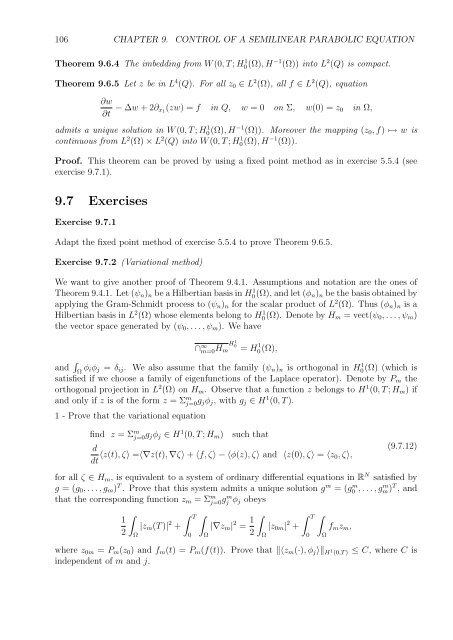Optimal Control of Partial Differential Equations
Optimal Control of Partial Differential Equations
Optimal Control of Partial Differential Equations
You also want an ePaper? Increase the reach of your titles
YUMPU automatically turns print PDFs into web optimized ePapers that Google loves.
106 CHAPTER 9. CONTROL OF A SEMILINEAR PARABOLIC EQUATION<br />
Theorem 9.6.4 The imbedding from W (0, T ; H 1 0(Ω), H −1 (Ω)) into L 2 (Q) is compact.<br />
Theorem 9.6.5 Let z be in L 4 (Q). For all z0 ∈ L 2 (Ω), all f ∈ L 2 (Q), equation<br />
∂w<br />
∂t − ∆w + 2∂x1(zw) = f in Q, w = 0 on Σ, w(0) = z0 in Ω,<br />
admits a unique solution in W (0, T ; H 1 0(Ω), H −1 (Ω)). Moreover the mapping (z0, f) ↦→ w is<br />
continuous from L 2 (Ω) × L 2 (Q) into W (0, T ; H 1 0(Ω), H −1 (Ω)).<br />
Pro<strong>of</strong>. This theorem can be proved by using a fixed point method as in exercise 5.5.4 (see<br />
exercise 9.7.1).<br />
9.7 Exercises<br />
Exercise 9.7.1<br />
Adapt the fixed point method <strong>of</strong> exercise 5.5.4 to prove Theorem 9.6.5.<br />
Exercise 9.7.2 (Variational method)<br />
We want to give another pro<strong>of</strong> <strong>of</strong> Theorem 9.4.1. Assumptions and notation are the ones <strong>of</strong><br />
Theorem 9.4.1. Let (ψn)n be a Hilbertian basis in H 1 0(Ω), and let (φn)n be the basis obtained by<br />
applying the Gram-Schmidt process to (ψn)n for the scalar product <strong>of</strong> L 2 (Ω). Thus (φn)n is a<br />
Hilbertian basis in L 2 (Ω) whose elements belong to H 1 0(Ω). Denote by Hm = vect(ψ0, . . . , ψm)<br />
the vector space generated by (ψ0, . . . , ψm). We have<br />
∩∞ H<br />
m=0Hm<br />
1 0 1<br />
= H0(Ω), and <br />
Ω φiφj = δij. We also assume that the family (ψn)n is orthogonal in H1 0(Ω) (which is<br />
satisfied if we choose a family <strong>of</strong> eigenfunctions <strong>of</strong> the Laplace operator). Denote by Pm the<br />
orthogonal projection in L2 (Ω) on Hm. Observe that a function z belongs to H1 (0, T ; Hm) if<br />
and only if z is <strong>of</strong> the form z = Σm j=0gjφj, with gj ∈ H1 (0, T ).<br />
1 - Prove that the variational equation<br />
find z = Σ m j=0gjφj ∈ H 1 (0, T ; Hm) such that<br />
d<br />
dt 〈z(t), ζ〉 =〈∇z(t), ∇ζ〉 + 〈f, ζ〉 − 〈φ(z), ζ〉 and 〈z(0), ζ〉 = 〈z0, ζ〉,<br />
(9.7.12)<br />
for all ζ ∈ Hm, is equivalent to a system <strong>of</strong> ordinary differential equations in R N satisfied by<br />
g = (g0, . . . , gm) T . Prove that this system admits a unique solution g m = (g m 0 , . . . , g m m) T , and<br />
that the corresponding function zm = Σ m j=0g m j φj obeys<br />
<br />
1<br />
|zm(T )|<br />
2 Ω<br />
2 T <br />
+ |∇zm|<br />
0 Ω<br />
2 = 1<br />
<br />
|z0m|<br />
2 Ω<br />
2 T <br />
+ fmzm,<br />
0 Ω<br />
where z0m = Pm(z0) and fm(t) = Pm(f(t)). Prove that 〈zm(·), φj〉 H 1 (0,T ) ≤ C, where C is<br />
independent <strong>of</strong> m and j.

















